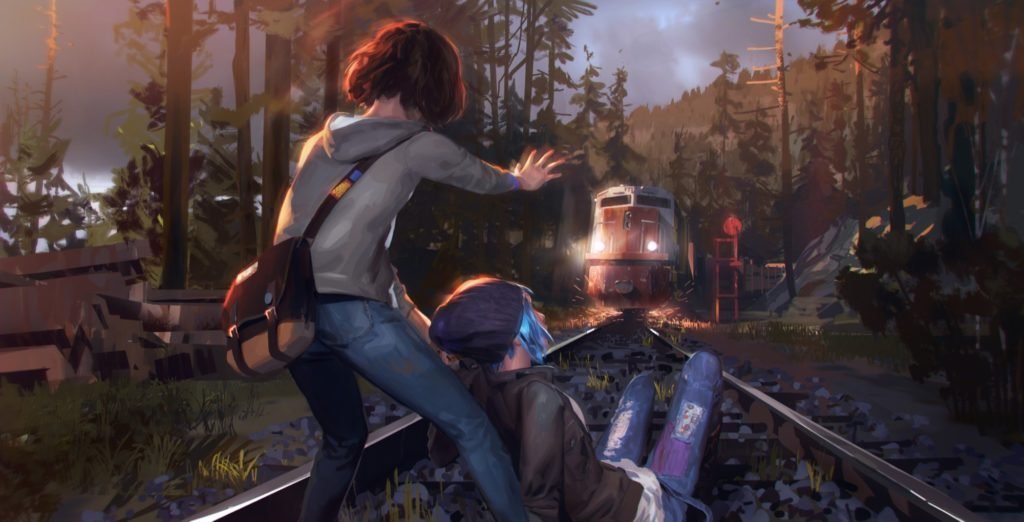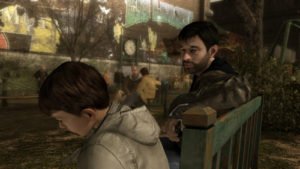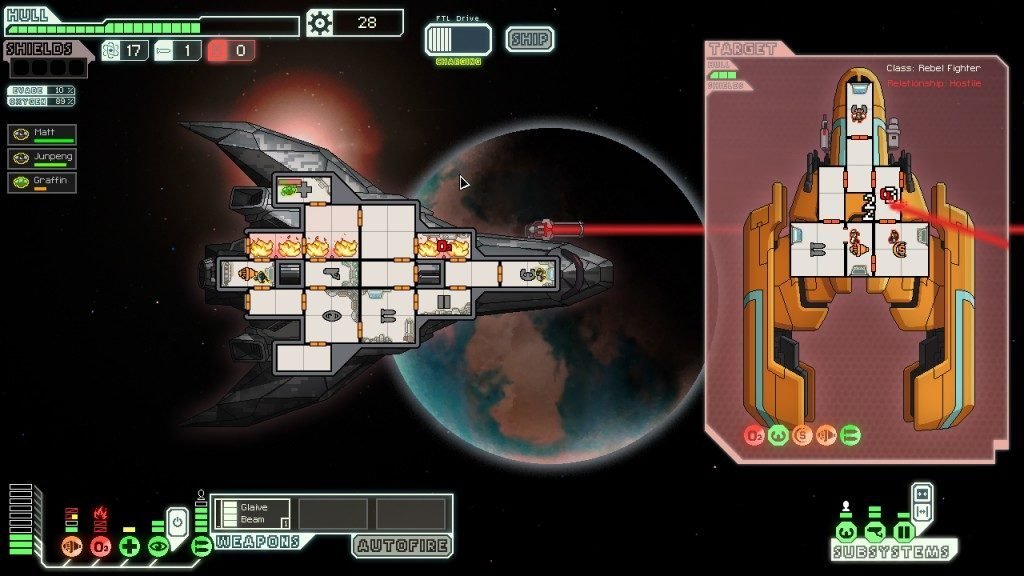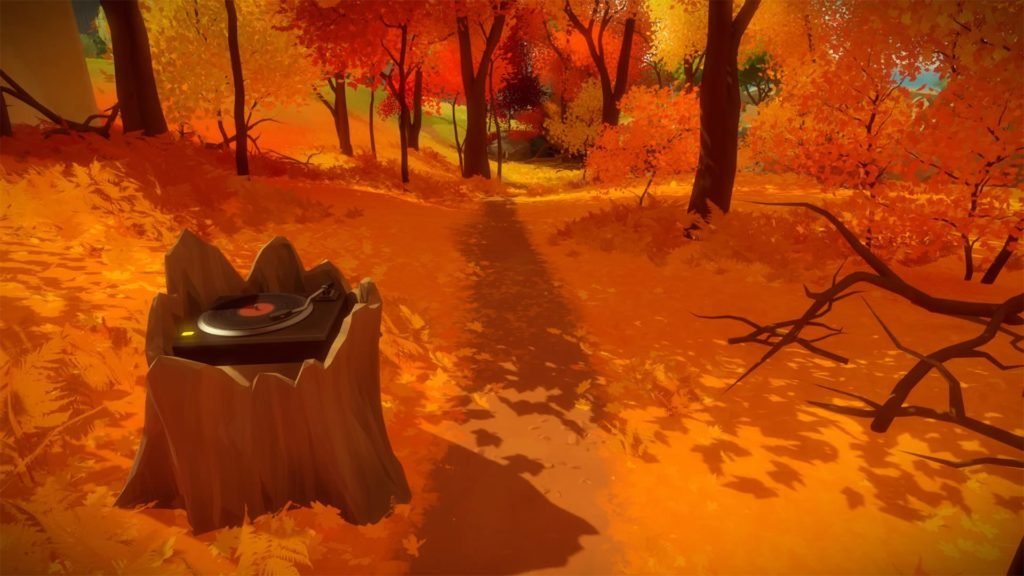Table of Contents
The problem isn’t usually that people don’t believe games can tell powerful stories, it’s that people don’t think they’ll play a game all the way through. People are more likely to finish story games– or anything else– if they do so with someone else. So, I’ve compiled a list of games for non-gamers to play with gamers. All the games on this list:
– have a narrative.
– can be played by an inexperienced gamer.
– work well with the non-gamer playing, but talking things through with the gamer.
– are story games I’ve personally seen through and can vouch for.
The Walking Dead, Season 1

The Walking Dead, Season 1 is arguably the game that popularized decision-based games in the modern market. Developer Telltale Games had sharpened their teeth on several other Intellectual Properties (IPs) before getting their hands on the hyper-popular Walking Dead franchise, and they made quite a few smart decisions with this game: It uses a different cast from the comic and T.V. shows, it’s broken up into 5 movie-length “episodes” with game-diverging decisions spread evenly throughout, and it focuses on the complex relationship between adult protagonist Lee and the eight-year-old Clementine– do you teach her to be kind, or to survive?
Telltale has a few strong games, like fable-noir hybrid The Wolf Among Us and the bubbly Tales From The Borderlands, and a few enticing let-downs (Game Of Thrones: Iron From Ice comes to mind), but The Walking Dead S1 is the only game to ever make me cry. It’s one of the best story games I’ve ever played, and one of the most accessible.
It’s decisions are tough but smart, and usually split people close to 50/50. Imagine a more humanistic cast than the TV show, with better acting (Telltale’s tech is limited, but boy can they animate a face). But a word of warning: You can play its DLC The Walking Dead: 400 Days afterward, but The Walking Dead, Season 2 is a poorly-constructed mess, it falls apart if you disagree with one character, and it retroactively detracts from S1. So just play S1: It’s more than enough.
Life Is Strange

Telltale unfortunately poisoned the pool a bit on decision games with some weak releases, and also with how formulaic their system is: Once you’ve played two or three games, you can see the script a mile ahead of the action. Life Is Strange is a fantastic alternative to Telltale’s games– or even follow-up.
It follows an artsy high school student as she discovers she has limited and debilitating time-control powers. Mechanically, this allows you to rewind and remake (most) decisions. It’s all fun and games with how much everyone would love do-overs in high school, and then the game knows how to deal with mature subject matter with a surprisingly deft hand. Mental illness, disability, sex crimes, and violence reach extreme conclusions, but not for shock so much as discussion. And they’re treated with the appropriate weight. Equally nice is that most of the problems (mechanically, narratively, the use of “hella”, or otherwise) that exist in the first episode or so are resolved by the end.
There’s more “Butterfly Effect” in Life Is Strange than many decision-based titles (which the game is quick to blatantly point out with a literal butterfly), which makes for a satisfying experience. Developers Don’t Nod learned from Telltale’s mistakes in a big way, making one of the best story games out there. And there looks to be a sequel coming.
Until Dawn

I could leave this section at saying “Imagine playing the best slasher flick you’ve ever seen”, but I’ll say a bit more. Its characters definitely fall into archetypes, but they’re taken in such interesting directions that you’ll turn around your opinion on some of them. The threats and obstacles are satisfyingly substantial and justifiable. And there’s a ton of thrill, even for a story game.
Part of the fun comes from finding “totems” which show clips of future events, with a corresponding category like “fortune” or “death”. Finding totems and then trying to recognize where they’re happening in the middle of the action is the perfect gamification of “don’t go in there!” It can get violent and intense, and your characters very much can die, but if you like horror movies, this is a strong pick– especially if you have a significant other to play with.
Heavy Rain

I have to put some disclaimers on this one: This is a David Cage game, and his games have a lot of problems. Controls aren’t always responsive (which can lead to character deaths). His female characters frequently find themselves in various states of undress and peril. And while I won’t say much about this game’s story, I will say it’s a gripping mystery– up until the third act and subsequent reveal, which both require preemptively checking your brain at the door to enjoy.
That said, Cage games do a fantastic job on small, human moments; one of the first sequences is being a inept single parent and running out of time to do everything you said you’d do for a kid. And Heavy Rain does do a good job of spinning a yarn and putting the protagonist through affecting and smart Saw-like challenges. It’s a fun ride, as long as you’re just as willing to invest in a story as to step back and laugh when the third act falls apart.
It’s certainly the most adult of his games. Indigo Prophecy unsuccessfully crammed several games worth of nonsense into one game with baffling controls which rip off Simon Says. Beyond: Two Souls has some punchy moments, but has all of Cage’s problems with women characters in a single female protagonist, and [SPOILER] features a goddamned Chinese underwater ghost lab [SPOILER END]. If you’re interested in a flawed auteur with some serious cinematic flair, and story games that are at least fun, try Heavy Rain. (Disclaimer: The main reason this made the list is because enough people have told me I’m wrong about this game that I’m willing to admit I might be.)
FTL: Faster Than Light

This one I can pitch best by explaining my experience with it. I was studying abroad with my best friend, and neither of us could afford to come home for Christmas. We spent it in Switzerland with some extended family; beautiful, but homesick. So he suggested I try this game he’d played a lot, and name every character in it after one of our closest friends.
This isn’t technically a game meant for multiple players. You start out with a certain space ship and crew, and you travel across solar systems. You can stop at different points in the hope of getting more resources or ship upgrades, but you can also be attacked, waste resources, and run out of time before the force chasing you catches up. Each decision is a roll of the dice, so you try to put yourself in situations you have the gear and crew for.
It’s common to wipe early, but my best friend was a great guide– he told me which aliens I should recruit, what gear had the most uses, etc. At the end of the game, we had every one of our close friends represented in an alien we thought fit their personality. By the time we were teleporting two of our praying mantis friends into the enemy ship to destroy a laser cannon from the inside, while pushing a rock alien through a fire and praying he didn’t run out of oxygen, and while two of our humans miraculously took out three enemies, we were cheering. We won without a single death. Your mileage may vary, and there are a lot of games like this one, but it’s the most accessible one I know. (Disclaimer: You make a lot of this story game’s story yourself, but there’s a frame narrative that keeps you going.)
Papers, Please

If you’ve ever done paperwork, you’ll enjoy this one. Bear with me here. You’re a border patrol guard to a soviet-like state, and you have to make sure everyone’s passports check out via your smorgasbord of manuals. You have a tiny desk that doesn’t fit all the papers, so you constantly have to switch which are on top. You have a time limit, and if you make too many mistakes or don’t process enough people, you won’t make enough to feed your family at night or treat their illnesses. And this one guy keeps coming back with hand-drawn crap. It’s one of the more unusual story games, and stories, to say the least.
And yet, the game’s a thrill. Having two sets of eyes on the passports makes it a much more palatable experience, and the game has a lot of tricks up its sleeve– bribery, threats, pleas. When someone you like says she’ll die if she isn’t let through, when you desperately need money and can’t even choose to do “the right thing” or you’ll game over, when someone’s whispering about a bomb, what do you do? Better ask your gamer friend. If everything goes wrong, you can blame him, at least.
Inside

This is one of those games where you just have to play it. I’ll say everything I can without spoilers, though. It’s a platformer, though the puzzles are intuitive and usually simpler than they appear– which means novices can get through it. It’s a fairly quick game, just a couple hours. And there’s no dialogue; everything is told through powerful visuals and surprisingly responsive gameplay.
Watch a trailer to get the mood, and if it hits the right notes for you, just switch off who’s playing as wished. This is a game that’s definitely powerful experienced in silence, but you’ll want to talk about it so much that having someone there at the same time is a benefit to the experience. And the puzzles are so much dark fun at times. [MINOR SPOILER] When the game requires 20 people at one point, their definition of “people” is really loose. [SPOILER END] It’s a 10/10 not just for being one of the best story games ever made, but for being one of the purest– it did exactly what it set out to do, nothing more, nothing less.
The Witness

I don’t think it’s possible to have a complete gaming education without touching a Jonathan Blow game, and Braid gets tricky for a first-timer. The Witness, however, is the experience of insight in a nutshell.
Everything in the game is line puzzles. Well, that’s sort of true; the core of every puzzle is a line puzzle. The game takes that in absurd directions though, leaving clues scattered around the island, as well as some of the most playful level design you’ve ever seen. In one area, there’s a statue reaching for the sky in agony, but when you look at its shadow, some rocks have been placed in an arc between his hands so he looks like he’s juggling.
This game challenges perspective in ways I’ve never seen before. A friend and I tackled it often, and the breakthrough we had about the desert puzzles had our jaws on the floor. And discovering a few of the puzzles transcended our previous experiences with games. When a game suddenly springs a video clip on you, and its the last 15 minutes of a black-and-white, wordless art flick, and you watch the whole thing silently because the reference explains so much of what the game is trying to do… that’s special. Grab a friend, pen, and paper, make sure you don’t check out any walkthroughs for at least a few hours, and throw yourselves at these puzzles. You won’t find another experience like it. (Disclaimer: Defining this as a story games is …loose. But trust me, it’s there.)
And that’s it!
There are articles coming up on story games for non-gamers to tackle alone (with a gamer watching) and advanced story games for gamers to show their non-gamer friends how far games can go. When those go up, I’ll link them here. Hope you can enjoy some of these games (with someone else)!

